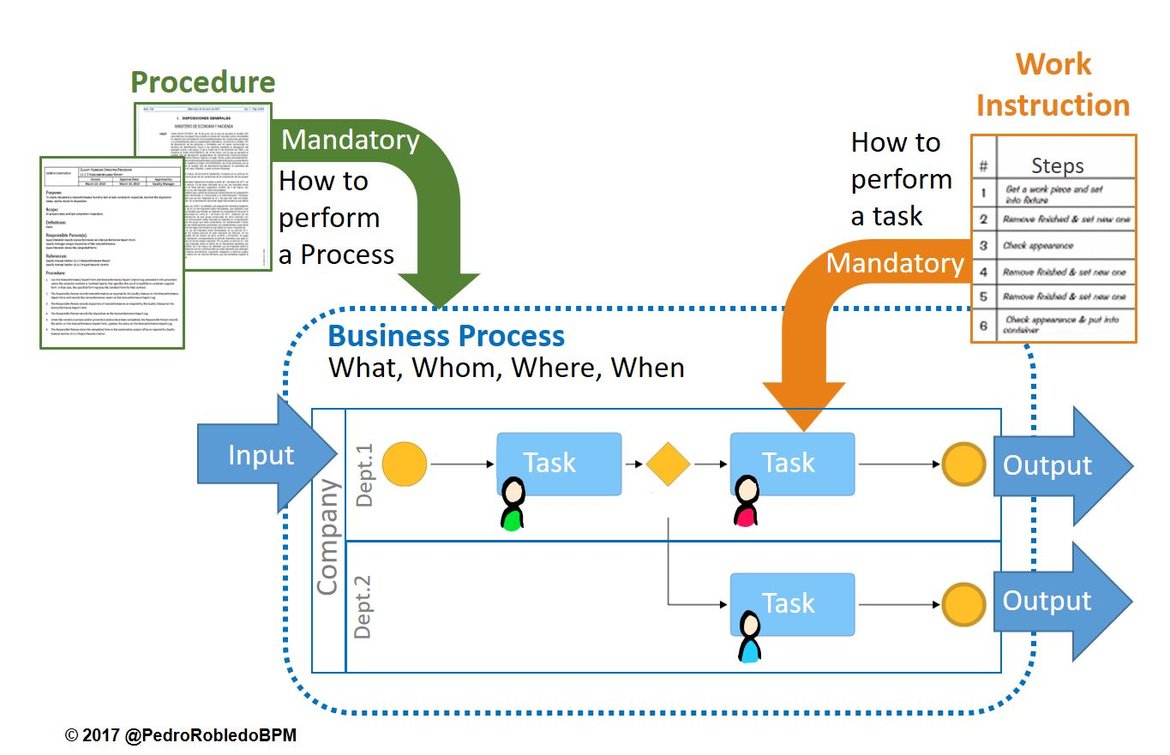¡HI! If you want to propose us a project, send a mail to info@albatian.com


ALL INFORMATION ABOUT
BPM, PROCESS, R & D, TECHNOLOGY
Differences between Processes, Procedures and Work Instructions
Por: Pedro Robledo, BPM process management expert

Many people often confuse these three terms: business Process, Procedure, and Work Instruction. In fact, most people write work instructions and call them procedures, and define a procedure as a process. My objective in this paper is to provide the difference amongst the three terms to help you understand when to use each term in the Quality Management of your Business.
The ISO 9001:2015 standard (Quality management systems - Fundamentals and vocabulary) defines the concept of Business Process as: "A set of related or interacting activities, which transform inputs into outputs". It is possible to qualify something more by saying that a process is a sequence of activities with a realization order in time, which converts a given input into an output (result, a product). Any activity, or set of activities, that uses resources to transform input elements into results can be considered as a process.
Business Processes are modeled on the Business Process Model and Notation (BPMN) standard, reflecting the start of the process, the responsibilities of the activities, the sequence flows with all possible paths (to collect all the exceptions through decision points), the activities to be carried out, the roles that execute each activity, the events that occur in the process and the finalization (one or several end events) of the process.
Do not confuse procedure with process. The ISO 9001: 2015 says that a Procedure is: “specified way to carry out an activity or a process”. When you have a process that must happen in a specific way, and you specify how it happens, you have a procedure. The procedure is mandatory and is necessary to develop any Quality Management System. Please pay your attention that not all processes need to have a procedure, and that the same process may have associated one or several procedures.
A procedure will be determined by the need to detail the specific way of doing the activities by legal issues, regulatory compliance or company policies. The procedures are used for those activities in which several operations are linked and different people or departments of the company are involved (for example, Procedure for the presentation of Fiscal Models in the Treasury, Purchasing Procedure, Supplier Evaluation Procedure, Automation Procedure of Invoices, Procedure for Risk Work…).
Work Instructions are documents that clearly and precisely describe the correct way to perform certain tasks that may cause inconvenience or damage if not done in the established manner. That is, describe, dictate or stipulate the steps that must be followed to correctly perform any specific activity or work. For example, Document of the Purchasing Area that describes the Accreditation Documentation of the Expense to be presented by the Employee in his Expense Note and the steps to proceed to present his monthly expenses; this work instruction would be linked to the "Submit Expense Note" Activity.
The work instructions are mainly focused on explaining how a specific activity is going to be carried out, and they are mandatory. The work instructions are used to describe a specific operation, usually associated with a job. If they are not mandatory, we would be talking about a Work Guide.
Main Differences between Process, Procedure and Work Instruction
|
PROCESS |
PROCEDURE |
WORK INSTRUCTION |
|
Flow of sequences of activities that transform input elements into results |
Specific way to carry out a process |
Describe the correct steps to perform a specific task.
|
|
What we do By WHOM Where it takes place When it happens |
How the work has to been performed and why |
How accomplish a specific task within a process with very detailed directions |
|
Orchestration the work |
Mandatory method |
Mandatory guidance |
|
Can respond to 0, 1 or more procedures |
It may consist of 0, 1 or more work instructions |
Focus on the instructions of 1 task |
|
Transversal by Business Units |
Cross-Functional or only 1 business unit |
Only 1 business unit |
|
Participate more than one role |
Participate more than one role |
Participate only one role |
|
Encapsulates activities |
Explains how to do but doesn’t get to the all details of how it is done |
All the detail of all the steps to follow in an activity |
|
Provides the workflow model in BPMN at a high level |
Document with both narrative and images, usually in the form of use cases and workflow diagrams |
Document with the maximum detail that explains step by step the instructions that must be carried out in an activity |
DIFFERENCES REGARDING QUALITY MANAGEMENT
BPM helps execute business processes to achieve compliance with the Quality Management System so that the organization keeps all the documented information (mandatory records) for ISO quality audits.
A procedure is usually described in a Word document, but could include the complete diagram in BPMN that explains at a high level the different activities to be performed. The ISO 9001 standard requires documented procedures for effective planning, operation and control of the processes within the quality management system of a company, which will include the documented information necessary to support the operation of the processes.
The work instructions are optional for a system based on ISO 9001, but are generally included for consistent operations. The instructions are written to give instructions in a logical work sequence.
|
PROCESS |
PROCEDURE |
WORK INSTRUCTION |
|
Ensures the preservation of all documented information (mandatory records) and traceability for ISO quality audits |
Documented information required (required by ISO 9001) for effective planning, operation and control of processes |
Instructions are optional for a system based on ISO 9001, but are generally included for consistent operations |
|
Ensure that the Quality Management System (QMS) runs correctly and consistently in order to run according to the required policies and regulations |
Ensure that the Quality Management System (QMS) be defined correctly in order to run according to the required policies and regulations |
Ensure consistent operations made by a person in a task according to the required policies and regulations |
CONCLUSION
The BPMN Business Process will be supported if necessary by procedures for mandatory legislative or regulatory compliance or company policies. And it will be supported by work instructions to document the obligatory steps to follow in those activities that require it.
RELACIONADO
-
Industry 4.0: the bpm challenge
by 4 July 9, 2017
-
Process Mining plays an essential role in Digital Transformation
by 4 Sept. 6, 2018
-
Not enough with an independent Management of a Process
by 4 May 9, 2017
-
Any Business Innovation and Transformation requieres an Enterprise Architecture
by Albatian March 27, 2017
-
How to select a BPM software?
by 4 Dec. 17, 2018
-
Lean+SixSigma+TOC provide methods for continuous process improvement in BPM
by Albatian Feb. 13, 2017
-
Before automating a process ... improve it!
by 4 Jan. 8, 2020
-
Process Digitalization in Digital Transformation
by Albatian Jan. 9, 2017
-
Why BPM is vital for companies in the energy and utility industry
by Albatian July 13, 2020
-
BPM is key to the Digital Transformation
by Albatian Oct. 4, 2016
-
How to guide organizations in Maturity in BPM?
by 4 March 16, 2019
-
BPM is the most effective discipline of business management
by Albatian Sept. 15, 2016
-
Knowledge management and human component of BPM projects
by Albatian Feb. 19, 2013
-
¿BPMS for moments of crisis?
by Albatian Nov. 12, 2012











